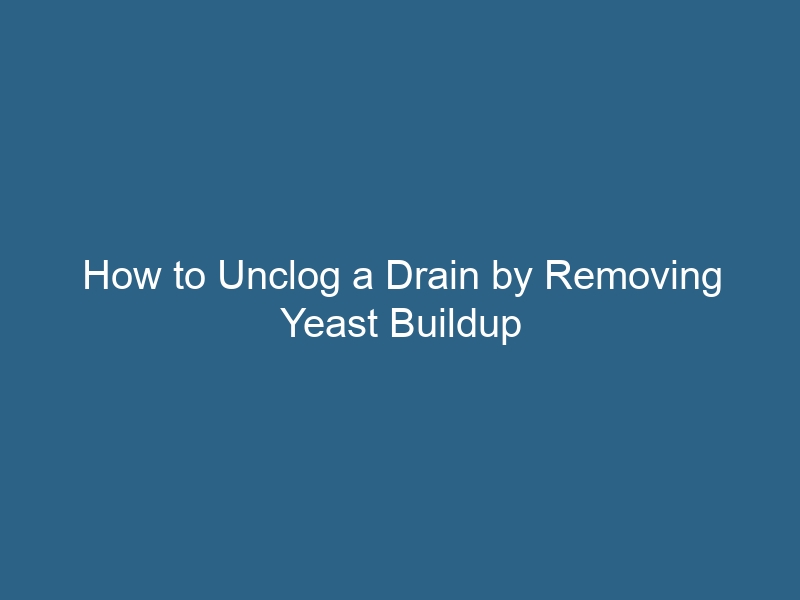Quck answer
To remove a yeast clog from a drain, follow these steps:
1. Boil water and pour it down the drain. This helps to soften the yeast and loosen the clog.
2. Mix equal parts of baking soda and vinegar in a bowl. Pour the mixture down the drain. The chemical reaction helps to break down the yeast.
3. Let the mixture sit in the drain for about 30 minutes.
4. Boil more water and pour it down the drain again to flush out the loosened yeast.
5. Use a plunger to further dislodge the clog if necessary.
6. Repeat the process if the clog persists.
Remember to take preventive measures to avoid future yeast clogs, such as avoiding pouring yeast-based products down the drain.
If you’re searching for natural solutions to clear a clogged drain, you may come across recommendations to use yeast. The suggested method involves pouring a tablespoon of instant yeast followed by a tablespoon of sugar down the drain, which supposedly helps to loosen the organic matter that is blocking the pipes. Unlike traditional harsh drain cleaners, yeast is considered safe and even beneficial for septic systems. In fact, you can even try using fizzy beer as a drain cleaner if you have a spare bottle.
But what should you do if yeast is actually causing the clog? The solution is to treat it like any other clog. If the yeast has accumulated in the P-trap, attempt to break it up using a long tool such as a Zip-It tool. If that doesn’t work or if there is a solid mass of yeast, known as a sugar snake, in the drain, try plunging the sink and using vinegar and baking soda to dislodge it. As a last resort, you may need to dismantle the P-trap and manually clean it.
The Yeast May Be Stuck in the P-Trap
If your drain is clogged with flour or yeast, it could be adhering to hardened grease, soap, or starch. However, it is also possible that the yeast has settled at the bottom of the P-trap and formed a solid mass. It would require a significant amount of yeast poured into the drain for this to occur, but it could happen if you were baking bread or brewing beer.
A Zip-It tool, which resembles a cable tie with barbed edges, is long enough to reach most sink traps and can be used to puncture through the mass. It is affordable and easier to use compared to a sink auger, and it can fit through a basket strainer. Once you create a hole, flushing the drain with a gallon of boiling water should wash away most of the mass.
If you already have a sink auger, you can use that as well if it fits through the strainer.
Dealing with a Sugar Snake in the Drain
If it has been a while since you last cleaned the drain and bacteria have been thriving, fueled by sugar and yeast, the blockage may have taken the shape of the pipe. This type of clog is known as a sugar snake, and the best approach is to use an enzyme drain cleaner. Ideally, you should use an enzyme cleaner as a preventive measure rather than a solution for existing clogs, but it can still clear a clogged drain, although it may take a day or two.
Enzyme drain cleaners are readily available and easy to use, but it is important to read the instructions on the container to ensure proper usage. Some products even come with automatic dispensers for sinks that serve soda fountains, adding a small amount of drain cleaner whenever sugary water goes down the drain. These products are referred to as soda fountain drain cleaners and can be beneficial to have on hand if you frequently pour sugary substances into the drain.
Two Effective Methods for Unclogging Drains
Plumbers often suggest using plunging as the initial approach to unclog a drain. By applying the right technique, the plunger exerts pressure on the blockage and breaks it up. Once the water starts flowing, you can proceed with a vinegar and baking soda mixture to complete the cleaning process. Remember to fill both the sink and the plunger with water before plunging to ensure effective results, as pumping air, which is compressible, may not be effective.
After the water begins to flow, add 1/2 cup of baking soda to the drain, followed by a solution of equal parts vinegar and hot water. Allow the foaming to subside for approximately 10 minutes, and then pour a gallon of boiling water down the drain. This treatment is usually sufficient to eliminate most yeast clogs. However, if the clog persists, it may be necessary to dismantle and clean the P-trap.


